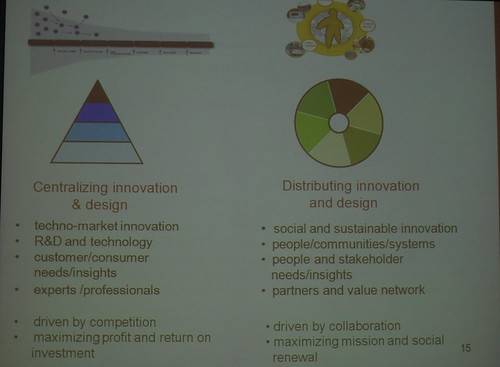The opening session was really about a discussion of what ‘better’ means to different people, I particularly like Julia Lohmann’s idea of ‘nothingness’, where people have more time to think and enjoy life rather than busy getting it stuffed by stuff…
I am rather impressed by the two speakers from Philips. Gavin Proctor talked about their extended product life cycle that goes beyond the line of consumption, but into disposal and recycle of Philips product as well.
The closing keynote was from the brilliant Josephine Green, who previously worked as the Senior Director of Trend and Strategy at Philips Design. She took us through the change we are experiencing in terms of social structure, or in her words ‘from pyramids to pancakes’. Couple of key characters of the pancake society is around the distributing innovation, collaboration, community and sustainability. Well, according to my knowledge, you can find some related arguments in Zuboff’s Support Economy and Gary Hamel’s Future of Management – both talked about the power shift towards stakeholders and their role in open and social innovation. It is quite inspiring to see how international company that previously has a reputation in manufacturing, such as Philips, stand up and talk about what social change means to them and how they face the challenge to move ahead.

And for fans of social innovation, here is a link from her presentation regarding some tools and methods for social innovation that may interest you: www.socialinnovationexchange.org
There was a concern expressed at the conference regarding whether it is too optimistic to this bright future Green presented, as the environmental scientists are basically telling us it’s too late. Well, wonderful Ms Green replied ‘it is our moral responsibility to keep optimistic in difficult times.’ and she also said ‘Life is a bitch.’ – wise words!

Interestingly, the next day of the conference, I found this rather odd little box outside Waitrose in Newcastle city centre full of green tokens. So it was the Community Matters Theme from Waitrose. They ask their customers to help them choose how much they should fund in community projects, so their investment is driven by community for community. Customer who shopped in the store were given a green token to vote for the community project they would like to support, and then Waitrose will invest money in these projects according to the result of the voting. A rather engaging approach to present community development to Waitrose's customers, don't you think?
By the way, I voted for the wild animal one, and then an lovely lady passed by me, put her token into the same box and told me 'nice choice~' - haha!
So supermarket is catching up by placing themselves as an active part of the community and support local development. Why don't we have Waitrose in Dundee? Can we vote for that as well?
